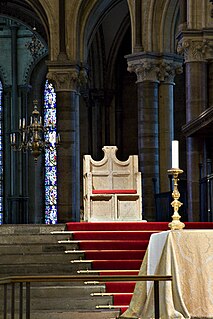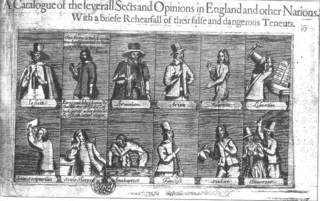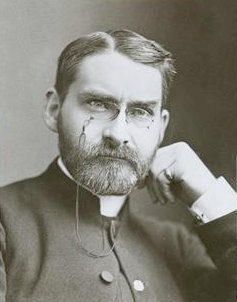Evangelicalism, evangelical Christianity, or evangelical Protestantism, is a worldwide, trans-denominational movement within Protestant Christianity which maintains the belief that the essence of the Gospel consists of the doctrine of salvation by grace, solely through faith in Jesus's atonement. Evangelicals believe in the centrality of the conversion or "born again" experience in receiving salvation, in the authority of the Bible as God's revelation to humanity, and in spreading the Christian message. The movement has long had a presence in the Anglosphere before spreading further afield in the 19th, 20th and early 21st centuries.

The United Kingdom of Great Britain and Ireland was a sovereign state established by the Acts of Union 1800, which merged the kingdoms of Great Britain and Ireland.
The General Assembly of Unitarian and Free Christian Churches is the umbrella organisation for Unitarian, Free Christians and other liberal religious congregations in the United Kingdom and Ireland. It was formed in 1928, with denominational roots going back to the Great Ejection of 1662. Its headquarters building is Essex Hall in central London, on the site of the first avowedly Unitarian chapel in England, set up in 1774.

The formal history of the Church of England is traditionally dated by the Church to the Gregorian mission to England by Saint Augustine of Canterbury in AD 597. As a result of Augustine's mission, and based on the tenets of Christianity, Christianity in England fell under control or authority of the Pope. This gave him the power to appoint bishops, preserve or change doctrine, and/or grant exceptions to standard doctrine.
A dissenter is one who disagrees in matters of opinion, belief, etc. In the social and religious history of England and Wales, and, by extension, Ireland, however, it refers particularly to a member of a religious body who has, for one reason or another, separated from the established church or any other kind of Protestant who refuses to recognise the supremacy of the established church in areas where the established church is or was Anglican.
Disestablishmentarianism is a movement to end the Church of England's status as the official church of the United Kingdom.

English Dissenters or English Separatists were Protestant Christians who separated from the Church of England in the 17th and 18th centuries.

Hugh Price Hughes was a Welsh Protestant clergyman and religious reformer in the Methodist tradition. He served in multiple leadership roles in the Wesleyan Methodist Church. He organised the West London Methodist Mission, a key Methodist organisation today. Recognised as one of the greatest orators of his era, Hughes also founded and edited an influential newspaper, the Methodist Times in 1885. His editorials helped convince Methodists to break their longstanding support for the Conservatives and support the more moralistic Liberal Party, which other Nonconformist Protestants were already supporting.

The Welsh Church Act 1914 is an Act under which the Church of England was separated and disestablished in Wales and Monmouthshire, leading to the creation of the Church in Wales. The act had long been demanded by the Nonconformist element in Wales, which composed the majority of the population and which resented paying taxes to the Anglican Church of England. It was sponsored by the Liberal party and opposed by the Conservative party.
David William Bebbington is a British historian who is a Professor of History at the University of Stirling in Scotland and a distinguished Visiting Professor of History at Baylor University. He is a Fellow of the Royal Society of Edinburgh and the Royal Historical Society.

Christianity is the largest religion in Wales. Until 1920 the established church was the Church of England, but from 1920 the disestablished Church in Wales, still Anglican, was self-governing. Wales also has a strong tradition of nonconformism, including Methodism.

The Education Act 1902, also known as the Balfour Act, was a highly controversial Act of Parliament that set the pattern of elementary education in England and Wales for four decades. It was brought to Parliament by a Conservative government and was supported by the Church of England, opposed many by Nonconformists and the Liberal Party. The Act provided funds for denominational religious instruction in voluntary elementary schools, most of which were owned by the Church of England and the Roman Catholics. It reduced the divide between voluntary schools, which were largely administered by the Church of England, and schools provided and run by elected school boards, and reflected the influence of the Efficiency Movement in Britain. It was extended in 1903 to cover London.
Christianity is the majority religion in Wales. From 1534 until 1920 the established church was the Church of England, but this was disestablished in Wales in 1920, becoming the still Anglican but self-governing Church in Wales. Wales also has a strong tradition of nonconformism and Methodism.

Protestantism is a Christian minority on the island of Ireland. In the 2011 census of Northern Ireland, 48% (883,768) described themselves as Protestant, which was a decline of approximately 5% from the 2001 census. In the 2011 census of the Republic of Ireland, 4.27% of the population described themselves as Protestant. In the Republic, Protestantism was the second largest religious grouping until the 2002 census in which they were exceeded by those who chose "No Religion". Some forms of Protestantism existed in Ireland in the early 16th century before the English Reformation, but demographically speaking these were very insignificant and the real influx of Protestantism began only with the spread of the English Reformation to Ireland. The Church of Ireland was established by King Henry VIII of England, who had himself proclaimed as King of Ireland.

The Toleration Act 1688, also referred to as the Act of Toleration, was an Act of the Parliament of England, which received the royal assent on 24 May 1689.
The Nonconformist conscience was the moralistic influence of the Nonconformist churches in British politics in the 19th and early 20th centuries.
Nonconformity was a major religious movement in Wales from the 18th to the 20th centuries. The Welsh Methodist revival of the 18th century was one of the most significant religious and social movements in the history of Wales. The revival began within the Church of England in Wales, partly as a reaction to the neglect generally felt in Wales at the hands of absentee bishops and clergy. For two generations from the 1730s onwards the main Methodist leaders such as Howell Harris, Daniel Rowland and William Williams Pantycelyn remained within the Church of England, but the Welsh revival differed from the Methodist revival in England in that its theology was Calvinist rather than Arminian. Methodists in Wales gradually built up their own networks, structures, and even meeting houses, which led, at the instigation of Thomas Charles, to the secession of 1811 and the formal establishment of the Calvinistic Methodist Presbyterian Church of Wales in 1823.

The history of religion in early Virginia begins with the founding of the Virginia Colony, in particular the commencing of Anglican services at Jamestown in 1607. In 1619, the Church of England was made the established church throughout the Colony of Virginia, becoming a dominant religious, cultural, and political force. Throughout the 18th century its power was increasingly challenged by Protestant dissenters and religious movements. Following the American Revolution and political independence from Britain, in 1786 the Virginia Statute for Religious Freedom disestablished the Church of England, ending public support and fully legalizing the public and private practice of other religious traditions.
The history of Christianity in Britain covers the religious organisations, policies, theology, and popular religiosity since ancient times.
The Liberation Society was an organisation in Victorian England that campaigned for disestablishment of the Church of England. It was founded in 1844 by Edward Miall as the British Anti-State Church Association and was renamed in 1853 as the Society for the Liberation of Religion from State Patronage and Control, from which the shortened common name of Liberation Society derived.










